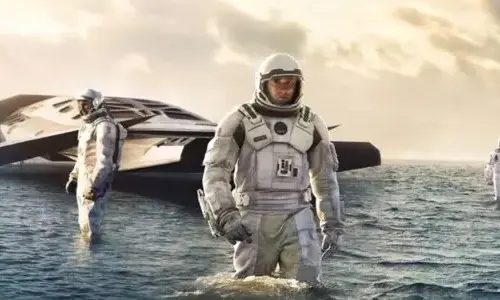100 interesting facts about space will blow your mind
With new space discoveries taking place every week, it's no surprise we wanted to write 100 random and interesting facts about this space!
Space facts are always fun to learn!
As time goes on, advancements in technology have seen us learn more facts about space over the past century than ever before.
We literally searched the universe for the most amazing space events, including facts about the planets of our solar system, the moons, the Milky Way and more!
Before you embark on your journey through time and space, check out the video below with 5 of our favorite space facts from this list!
Mercury & Venus are the only two planets in our solar system that do not have a moon.

In total, there are 176 confirmed moons orbiting the planets of our solar system, with some even larger than Mercury!
If a star gets too close to the black hole, it can be ripped apart.

For 20 years, a group of astronomers have observed a star in the center of our galaxy orbiting a black hole.
The star has now come close enough to the black hole to experience a "gravitational red shift", where the star's light loses energy as the black hole's gravity increases.
The hottest planet in our solar system is Venus.

Most people think this will be Mercury, as it is the closest planet to the sun.
However, Venus has a lot of gases in its atmosphere, creating a "Greenhouse Effect" that leaves a constant temperature of 864 ° F (462 ° C) everywhere on the plant's surface.
Our solar system is 4.57 billion years old.

Yes, give or take 30 million years (ish).
Scientists estimate that in about 5 billion years, our Sun will expand into a Red Giant.
In about 7.5 billion years its expanding surface will devour and engulf the Earth.
Enceladus, one of Saturn's smaller moons, reflects 90% of the Sun's light.

Because Enceladus's icy surface reflects sunlight instead of absorbing sunlight, the temperature drops to -394 ° F (-201 ° C).
The highest mountain discovered is Olympus Mons, located on Mars.

The peak is 16 miles (25 km) high, making it nearly 3 times higher than Mount Everest.
And it's not only tall but 374,015 ft² (114,000 m²) wide - that's the size of Arizona!
The Vortex Galaxy (M51) was the first known spiral object.

The large spiral arms of the Vortex Galaxy are made up of long lanes of stars and gas, sprinkled with a lot of space dust.
These arms act as star-forming factories, compressing hydrogen gas and creating new clusters of stars.
A light year is the distance covered by light for one year.

light travels at about 186,411 miles (300,000 km) per second.
So one light year is equivalent to about 5,903,026,326,255 miles!
The Milky Way is 105,700 light years wide.

A modern spaceship will take 450,000,000 years to travel to the center of our galaxy!
You can read more incredible space facts with this list of facts about the Milky Way!
The Sun is about 330,000 times heavier than the Earth.

It is about 109 times the diameter of the Earth and so large that the Earth can fit inside the sun about 1,300,000 times!
In fact, the sun is so massive that it contains 99.85 mass% of our solar system.
Footprints left on the Moon will not disappear in the absence of wind.

But wait a second… if there is no wind blowing them, why does the flag blow?
The ripple you see is caused by a stubborn telescopic crossbar that the astronauts have struggled to remove from the flag's upper bezel.
Still not sure if we've walked on the Moon yet?
Due to the lower gravity, a person weighing 220 lbs on Earth would weigh 84 lbs on Mars.

When sending droid to the Martian surface, this is what scientists planned, being able to load the droid with more devices and build it out of stronger materials.
There are 79 known moons orbiting Jupiter.

Jupiter is the planet in our solar system with the most moons, and it also has the largest moon in our solar system.
That moon is called Ganymede and is 33,279 miles (5262 km) in diameter - it's larger than Mercury and it's visible with just a pair of binoculars!
The day on Mars is 24 hours 39 minutes 35 seconds long.

So you'd assume that there are fewer days in a year on Mars than on Earth, right?
Since Mars orbits the sun more slowly than Earth, there are actually 687 Martian days in a Martian year!
NASA's observational satellite and crater sensor (LCROSS) found evidence of water on the Earth's Moon.

While water cannot exist on the Moon's surface under current conditions, scientists believe that water ice can exist in cold tanks, permanently obscured at the Moon's poles.
Every 25 - 35 days, the Sun makes a complete rotation.

So, for us on Earth, a full rotation is equivalent to a full day.
Want to learn more facts about space?
Earth is the only planet not named after a god.

No one knows how the Earth got its name;
Due to the gravitational pull of the Sun and Moon, we have tides.

This is because the tidal force of the Moon causes the Earth - and the water on it - to swell to the side closest to the Moon.
These blisters are the cause of high tides around the world.
Pluto is smaller than the United States.

If you were to walk around Pluto's equator it would be the same distance as walking from London to Denver International (well, say it takes 56 miles).
Mathematically, there may be white holes, although we haven't found them so far.

A white hole is a hypothetical region of space-time that cannot enter from the outside, even though matter and light can escape from within.
It is basically the reverse side of a black hole.
There are more volcanoes on Venus than any other planet in our solar system.

There are more than 1,600 large volcanoes on the surface of Venus, including a 5-mile (8 km) high volcano called the Maat Mons.
However, none of these volcanoes are known to be erupting today and most are probably long extinct.
Uranus's blue luminosity is due to the gases in its atmosphere.

Uranus's atmosphere is made up of hydrogen, helium and methane.
The methane gas in Uranus's upper atmosphere filters out all the red light from the Sun but bounces off the Sun's blue light into space, making it blue.
Like the truth about our space?
In our solar system there are 4 planets called gas giants: Jupiter, Saturn, Uranus and Neptune.

A gas giant is a large planet made up of mostly gases such as hydrogen and helium, and has only a relatively small rocky core.
Uranus has 27 moons that have been discovered so far.
It has 5 large moons and 22 small moons.
Because of its unique inclination, one season on Uranus equals 21 Earth years.

Also, the 97.77 degree inclination on Uranus's axis means that a day there lasted only 17 hours, 14 minutes, and 24 seconds.
Neptune's moon, Triton, orbited the planet in reverse.

Triton is the only major moon of the planets to do this.
This is called a orbit and astronomers are not sure why Triton orbits Neptune in this way.
Triton is slowly approaching the planet it orbits.

Scientists believe that when Triton finally gets too close to Neptune, it will be torn off by the planet's gravity and potentially create another ring around Neptune - giving it more rings
There are more stars in space than there are grains of sand in the world.

In the night sky there are 10 times more stars than Earth's sand grains, with 70 sex-ratio stars visible from Earth through telescopes.
In terms of numbers, 70 billion sextillion is: 70,000,000,000,000,000,000,000,000,000.
Neptune takes nearly 165 Earth years to form an orbit of the Sun.

That equates to 60,190 days for Earth to orbit the sun once!
This means that since its discovery in 1846, it has only completed a single trajectory!
You might also like the cool facts about Neptune out of this world!
Pluto's largest moon, Charon, is about half the size of Pluto.

Similar surfaces of Charon and Pluto are always facing each other, known as mutual tidal locks.
The International Space Station is the largest manned object ever put into space.

At 119 yards (109 meters) long, the International Space Station (ISS) sits about 250 miles (400 kilometers) above earth and is the third-brightest object in the night sky.
A day on Pluto lasted 153.6 hours.

This equates to 6 days 9 hours 36 minutes.
Check out other interesting space facts about Dwarf Planet, Pluto.
Saturn is the second largest planet in our solar system.

It has a radius of 36,184 miles (58,232 km) - nine times that of Earth.
However, due to its low density, it only weighs approximately 1/8 of the Earth.
Any fluid that moves freely in outer space will form a sphere on its own.

This is due to something called surface tension, which is an imbalance of gravity between molecules.
This can also happen in low-Earth orbit.
Mercury, Venus, Earth & Mars are known as the "Inner Planet".

They are named Inner Planets because they orbit the nearest Sun.
An inner planet is classified as an asteroid belt planet.
We know more about our Mars and Moon than we do about our oceans.

We have fully mapped the surface of Mars and Earth's Moon 100%, while we can only map about 5% of the ocean floor.
Black Arrow is the only British satellite to be launched by British rockets.

The Black Arrow was developed in the 1960s and was used for four launches between 1969 and 1971.
In 2019, it was recovered from the crash landing site in the Australian outback and on display in Penicuik, Scotland.
Only 5% of the universe is visible from Earth.

68% of the universe is dark energy and 27% is dark matter.
Light travels from the Sun to Earth in less than 10 minutes.

Photons emitted from the Sun's surface travel through space at the speed of light to reach our eyes in just 8 minutes and 20 seconds.
At any given time, at least 2,000 thunderstorms have occurred on Earth.

Worldwide, it is estimated that there are about 16 million thunderstorms each year.
About 100,000 of these thunderstorms occur in the United States alone.
You can read more strange facts about our Earth here.
The Earth's rotation is slowing down a bit over time.

This means shorter days ago.
If you were driving at 75 miles an hour, it would take 258 days to drive around Saturn's ring.

Saturn rings are approximately 175,000 miles long, although they are only about 3,200 feet thick.
You can learn more interesting facts about Saturn's rings here!
Outer Space is just 62 miles away.

Although there is no official strong boundary for where space begins, the Kármán stream lies 62 miles above sea level and is commonly used as the beginning of the universe in space treaties or archives.
The International Space Station orbits the Earth every 92 minutes.

The speed of the ISS as it orbits the Earth is about 17,150 miles per hour - that's equivalent to 5 miles per second!
Stars sparkle due to the way light is interrupted as it passes through Earth's atmosphere.

Starlight is influenced by wind in our atmosphere as it enters, as well as by different regions and temperatures.
This causes the light from each of the stars to sparkle as we look at them.
We always see the same side of the Moon, no matter where we stand on Earth.

This is because the Moon rotates on its axis at the same speed as the Earth.
There are three main types of galaxies: elliptical, spiral, and irregular.

The Milky Way, the galaxy in which our solar system lives, is classified as a spiral galaxy.
There are about 100 trillion stars in the Milky Way.

Of all the known galaxies, the Milky Way is the one that contains the most stars.
With the naked eye, you can see 3 - 7 different galaxies from Earth.

You can see the Fairy Galaxy (M-31), the Cloud Magellan, our Milky Way Galaxy, the Triangular Galaxy (M-33), the Omega Centauri Galaxy, and the Sagittarius Dwarf Spherical Galaxy.
In 2016, scientists discovered a radio signal from a source 5 billion light years away.

This means that when the signal started its journey, Earth didn't even exist.
The detected signals are located using the Very Large Array (VLA) of the National Radio Observatory Observatory in New Mexico.
The closest galaxy to us is the Fairy Galaxy - estimated to be 2.5 million light years away from us.

Before the discovery of the Fairy Galaxy, the Large Magellanic Cloud was thought to be the closest galaxy to us.
The first supernova observed outside our galaxy was in 1885.

This supernova, called S Andromedae, is located in the Andromeda galaxy.
This has been observed by Ernst Hartwig in Estonia and was only done thanks to the recent invention of the telescope.
The first black hole ever photographed was 3 million times the size of Earth.

The photo was released in April 2019 and shows a halo of dust and gas from Earth 310 million trillion miles.
It was captured by the Event Horizon Telescope, a network of eight linked telescopes, and was also captured using the programmer Katie Bouman's algorithm.
The distance between the Sun and the Earth is determined to be an Astronomical Unit.

The astronomical unit An (AU) is equivalent to about 93 million miles, or 150 million kilometers.
The second man on the moon was Buzz Aldrin.

She was born as Marion Moon and later married Edwin Eugene Aldrin.
Buzz Aldrin's birth name is Edwin Eugene Aldrin Jr.

He got the nickname "Buzz" due to his sister's mispronouncing the word "brother", which became "buzzer".
In 1988, he legally changed his name to "Buzz".
On Venus, it snows the metal and causes sulfuric acid to rain.

This is because Venus is a scorching planet choked by sulfuric acid, making its metals gas and then liquids in the atmosphere, before rain to the ground after heat.
Mariner 10 was the first spacecraft to visit Mercury in 1974.

It was launched at NASA's Kennedy Space Center in 1973, and flew by Venus three months later.
The second spacecraft to visit Mercury is the "Messenger", which completed 100% mapping of the Mercury surface in 2013.
The space was completely silent.

This is because there is no air in the space and requires air to carry sound vibrations.
So if you shout to someone beside you in space, they won't be able to hear you.
Coca-Cola is the first commercially available soft drink to be consumed in space.

The first food ever eaten in space was apple sauce and was eaten by John Glenn in space during the Friendship 7 mission in 1962.
Astronauts can grow up to approximately two inches (5 cm) in height while in space.

This is because the lack of gravity in the space causes the intervertebral discs to expand slightly.
However, this additional elevation is lost when re-entering Earth's atmosphere and subjected to Earth's gravity again.
The Kuiper Belt is an area of the Solar System out of Neptune's orbit.

The Kuiper Belt is a ring of icy objects and is home to Pluto.
The first woman in space was a Russian named Valentina Tereshkova.

It launched into both history and space during the Vostok 6 mission on June 16, 1963.
She spent almost three days in space and orbited Earth 48 times in her space before returning to Earth.
If Saturn's rings were 3 feet long, they would be 10,000 times thinner than a razor blade.

Saturn's rings are very thin because they are made up of water and dust fragments ranging in size from dust to rock.
The Hubble space telescope is one of the most efficient scientific tools ever built.

Astronomers using Hubble data have published more than 15,000 scientific papers.
We have more information on space and the Hubble Space Telescope here!
The first artificial satellite in space is called "Sputnik".

It was launched into an elliptical low-Earth orbit by the Soviet Union on October 4, 1957.
Exoplanets are planets that orbit other stars.

All the planets in our solar system orbit the Sun.
In 2009, NASA launched a spacecraft called Kepler to search for aliens, and has discovered thousands of planets since it was launched.
The heart of the Milky Way smells like rum and tastes like raspberry.

This is detected by the IRAM radio telescope on a cloud of gas called Sagittarius B2 in the center of our galaxy.
IRAM has discovered a chemical called ethyl formate that gives rum a distinctive odor and distinct flavor to raspberries.
You can read more about this fascinating space truth here - the Milky Way Taste Like Rum & Taste Like Raspberries
Our moon is moving away from Earth at a rate of 1.6 inches (4 centimeters) per year!

Scientists believe that the Moon will eventually move out of the Earth's gravity field;
Pluto is named after the god of the Roman underworld, not the Disney Dog.

The name of this planet was suggested by Venetia Burney, an 11-year-old British schoolgirl, who discovered the planet Clyde Tombaugh.
The Spacesuit helmet has a Velcro sticker to help astronauts from itching.

This is the sole and sole purpose of the Velcro patch.
More than 90% of Earth's population can see the ISS.

When you see the International Space Station (ISS) in the night sky, it appears like a fast-moving star crossing the horizon.
Saturn is the only planet that can float in water.

Although Saturn is the second largest planet in our solar system, it is also the lightest.
Saturn can float in water because it's mostly made of gas - despite the fact that you'll need a giant bath!
Asteroids are a byproduct of formation in the solar system, more than 4 billion years ago.

The introduction of Jupiter in our solar system prevented any planetary celestial bodies from forming between Mars and Jupiter, causing the small objects there to collide with each other and fragment into asteroids.
Astronauts cannot burp in space.

This is because no gravity in space means that the air in the astronaut's stomach does not separate and rise from the food eaten.
Uranus was originally known as "The Star of George".

This name is in honor of William Hershel's new patron, King George III.
The name "Uranus" was proposed in 1782, a year after its discovery, but was not used officially until 1850.
You may like these facts about when the planets in our solar system were discovered.
Sunset on Mars is blue.

Mars has less than 1% of Earth's atmosphere.
So sunsets on Mars are blue due to the way blue light from the Sun is collected in Mars' atmosphere.
The Earth is about 81 times heavier than the Moon.

The Moon's gravity, like other planets, differs depending on your position on its surface.
The first living mammal to enter space was a dog named "Laika" from Russia.

Laika is a stray hybrid dog on the streets of Moscow and was launched into space aboard the Soviet Sputnik 2 spacecraft on November 3, 1957.
Sadly, Laika died after 5-7 hours of flight due to overheating and stress.
The word "astronaut" means "star sailor" in its origin.

It is derived from the Greek words "astron", meaning "star", and "nautes", meaning "sailor".
So the word astronaut literally means "star sailor".
"NASA" stands for National Aeronautics and Space Administration.

It is an independent agency of the US Federal Government and was established in 1958.
NASA discovers new space facts every day, check out these NASA facts if you want to learn more!
Gennady Padalka has spent more time in space than anyone else.

He is an RKA astronaut and has spent 879 days in space
He has worked on both Mir and the International Space Station.
Mercury has no atmosphere, which means there is no wind and no weather.

Instead of an atmosphere, Mercury possesses a thin exosphere made up of atoms blown off the surface by the solar wind and attacked by meteorites.
In China, the Milky Way is known as the "Silver River".

In Japan and Korea, "Silver River" means galaxies in general, not just the Milky Way.
Low mass Red Dwarfs stars can burn continuously for 10 trillion years!

The Red Dwarf is a small, cool star at a later stage of its life and has a surface temperature below 7,200 degrees Fahrenheit.
Scientists used to believe that the same side of Mercury was always facing the Sun.

However, in 1965, astronomers discovered that the planet rotates three times in every two orbits it produces.
Jupiter's red spot is shrinking.

Jupiter's red spot is a giant swirling storm like a hurricane once the size of Earth!
Scientists are still confused about what is causing this even though they believe it could be due to jet jets on Jupiter changing position or direction.
A large percentage of the asteroids are pulled in by Jupiter's gravity.

For this reason, Jupiter is known as the landfill of the solar system.
Many potentially harmful asteroids, long-term comets, tend to be sucked into Jupiter's gravitational field.
Thanks Jupiter!
One day on Mercury equals 58 Earth days.

This is because Mercury rotates on its axis very slowly compared to Earth.
Since space has no gravity, the pen will not work.

Regular pens work by pulling the ink towards the nib (writing section) - when you hold the pen in your hand, the writing section is facing down.
Since there is no gravity in space, the ink is not pulled to the fuse.
However, special pens that work in zero gravity have been created.
On average, light takes only 1.3 seconds to travel from the Moon to Earth.

The distance between the Earth and the Moon is only 238,855 miles (384,400 km).
There are 88 recognized constellations in our night sky.

These 88 constellations cover the night sky of Earth and can be observed from the southern and northern hemispheres.
The center of a comet is called the "nucleus".

Lines of dust that form streaks behind a comet are known as a "coma" or "tail".
Space facts aren't just about planets!
As early as 240 BC, the Chinese began to record the appearance of Halley's Comet.

After 164BC, there is a continuous record of the comet every time it is seen.
In 2006, the International Astronomical Union reclassified Pluto as a dwarf planet.

This is because Pluto does not control gravity for the vicinity around its orbit.
There are 5 recognized dwarf planets in our Solar System.

The dwarf planets are Ceres, Makemake, Haumea, Eris and Pluto.
The dwarf planet Ceres is also the largest asteroid in our solar system and lies in the asteroid belt, making it the only dwarf planet that doesn't live outside the solar system.
Mars is the most habitable planet in our solar system.

In 1986, NASA found what they believe could be fossils of microscopic organisms in a rock recovered from the Martian surface.
Comet Halley will fly over Earth again on July 26, 2061.

The reality of this space is one of the things that kids will look forward to!
The famous comet was last seen on February 9, 1986 and orbits Earth only once in 75 to 76 years.
There is a planet half the radius of the Earth with a diamond surface.

55 Cancri e has eight times the mass of Earth, despite being half the radius and most likely has a graphite and diamond surface.
It is only 40 light years away and is visible to the naked eye under the constellation Cancer.
Buzz Lightyear from Toy Story has truly arrived in space!

Buzz Lightyear spent 15 months on the International Space Station and returned to Earth on September 11, 2009.
To infinity, and more!
We told you # 100 will make you smile!
Space, for many people, is a strange and wonderful thing.
We hope these 100 interesting space facts have made the space mystery… well, less mystery!
If you like these extraordinary spatial facts, we have more space truths for you to enjoy in our Space catalog.
All this interesting space information is correct at the time of writing, although we will update the space regularly - so please let us know if something comes up.
 52ºc, New York
52ºc, New York







